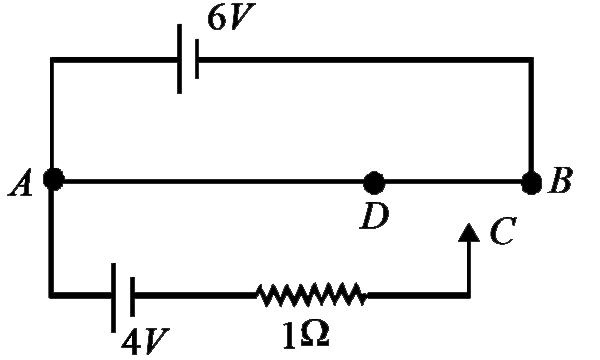An accumulator of emf 2V and negligible internal resistance is connected across a uniform wire of length 10 m and resistance 30Ω The appropriate terminals of a cell of emf 1.5V and internal resistance 1Ω is connected to one end of the wire and the other terminal of the cell is connected through a sensitive galvanometer to a slider on the wire. What is the length of the wire that will be required to produce zero deflection of the galvanometer? How will the balancing length change?
(a) When a coil of resistance 5Ω is placed in series with the accumulator.
(b) The cell of 1.5V is shunted with 5Ω resistor?
The correct Answer is:A, B

potential gradient across wire,
AB=210=0.2V/m
Now, VAC=1.5Vor(0.2)(ASC)=1.5
∴AC=7.5m
a. VAB=(RABRAB+5)×2=(3030+5)x2=127V

∴ Potential gradient across
AB=1270Vm
Now, VAC=1.5V
∴(1270)(AC1)=1.5
∴AC1=8.75m
b. VAC2=V
or (0.2)(AC2)=(55+1)(1.5)
or AC26.25cm
Topper's Solved these Questions
- CURRENT ELECTRICITYBook:DC PANDEYChapter:CURRENT ELECTRICITYExercise:Example
Explore 61 Videos
- CURRENT ELECTRICITYBook:DC PANDEYChapter:CURRENT ELECTRICITYExercise:Check point
Explore 70 Videos
- CURRENT ELECTRICITYBook:DC PANDEYChapter:CURRENT ELECTRICITYExercise:Level 2 Comprehension Example Type
Explore 2 Videos
- COMMUNICATION SYSTEMBook:DC PANDEYChapter:COMMUNICATION SYSTEMExercise:Subjective
Explore 11 Videos
- ELECTROMAGNETIC INDUCTIONBook:DC PANDEYChapter:ELECTROMAGNETIC INDUCTIONExercise:Medical entrances gallery
Explore 25 Videos
Similar Questions
A 6V battery of negligible internal resistance is connected across a uniform wire AB of length 100cm. The positive terminal of another battery of emf 4V and internal resistance 1Ω is joined to the point A as shown in figure. Take the potential at B to be zero.

2What are the potentials at points A and C ?
View SolutionA battery of emf 2V and internal resistance 0.5(Ω)is connected across a resistance in 1 second?
View Solution
Knowledge Check
A potentiometer has a uniform wire of length 10m and resistance 5Ω. The potentiometer is connected to an across a cell of e.m.f. 2 V and internal resistanc 10Ω. The reading of voltmeter is
A1mV/mB5mV/mC0.1 mV/mD4 mV/cmA cell of emf 2.0 V and internal resistance 0.1 Ω is connected with a resistance of 3.9Ω. The voltage across the cell terminals will be
A0.50 VB1.90 VC1.95 VD2.0 VA cell of emf 2 V and internal resistance 0.1Ω is connected with a resistance of 3.9Ω The voltage across the cell terminal will be
A1.95VB1.90VC0.50VD2.00V
A 6V battery of negligible internal resistance is connected across a uniform wire of length 1m . The positive terminal of another battery of emf 4V and internal resistance 1Ω is joined to the point A as shown in figure . The ammenter shows zero deflection when the jockey touches the wire at the point C. The AC is equal to

View SolutionA secondary cell of emf 2 V and finternal resistance 0.1 Ω is connected to the ends of a uniform wire of length 1 m and resistacne 12 Ω.A primary cell of emf 1.5 V in series with a galvancometer is connected to two points on the wire. If the galvanometer shows no deflection find the distance between the points.
View SolutionA cell of internal resistance 3 ohm and emf 10 volt is connected to a uniform wire of length 500 cm and resistance 3 ohm . The potential gradient in the wire is
View SolutionA 6V battery of negligible internal resistance is connected across a uniform wire of length 1m. The positive terminal of another battery of emf 4V and internal resistance 1Ω is joined to the point A as shown in figure. The ammeter shows zero deflection when the jockey touches the wire at the point C. The AC is equal to

View SolutionA battery having e.m.f. 5 V and internal resistance 0.5Ω is connected with a resistance of 4.5Ω then the voltage at the terminals of battery is
View Solution